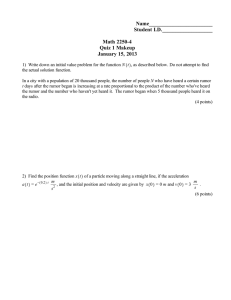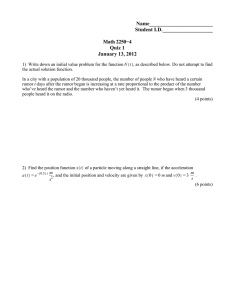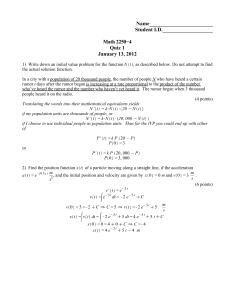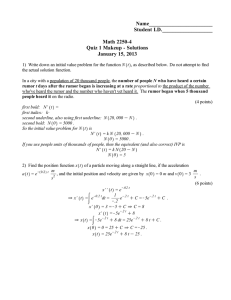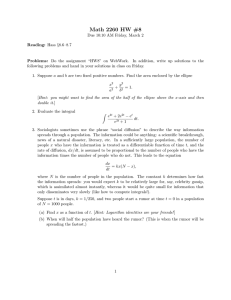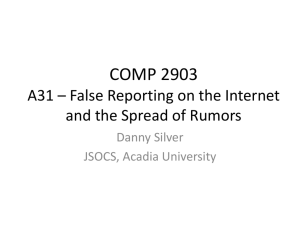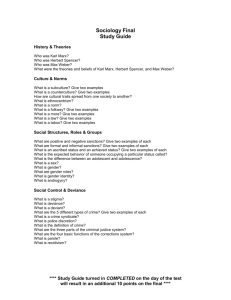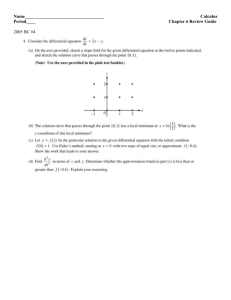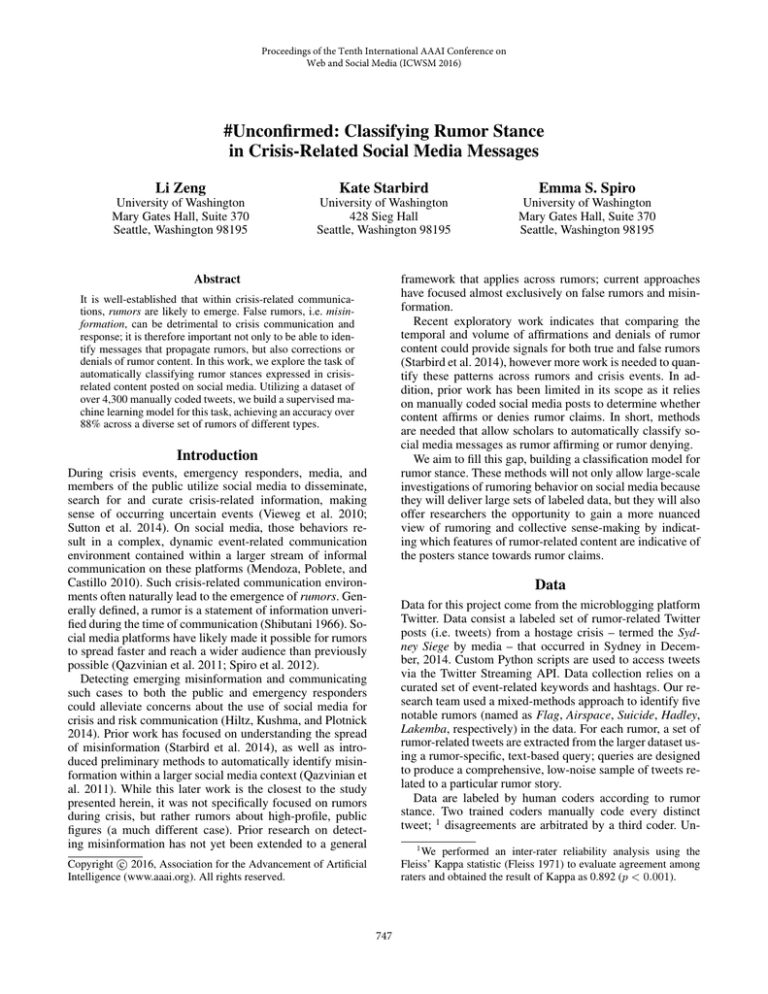
Proceedings of the Tenth International AAAI Conference on
Web and Social Media (ICWSM 2016)
#Unconfirmed: Classifying Rumor Stance
in Crisis-Related Social Media Messages
Li Zeng
Kate Starbird
Emma S. Spiro
University of Washington
Mary Gates Hall, Suite 370
Seattle, Washington 98195
University of Washington
428 Sieg Hall
Seattle, Washington 98195
University of Washington
Mary Gates Hall, Suite 370
Seattle, Washington 98195
framework that applies across rumors; current approaches
have focused almost exclusively on false rumors and misinformation.
Recent exploratory work indicates that comparing the
temporal and volume of affirmations and denials of rumor
content could provide signals for both true and false rumors
(Starbird et al. 2014), however more work is needed to quantify these patterns across rumors and crisis events. In addition, prior work has been limited in its scope as it relies
on manually coded social media posts to determine whether
content affirms or denies rumor claims. In short, methods
are needed that allow scholars to automatically classify social media messages as rumor affirming or rumor denying.
We aim to fill this gap, building a classification model for
rumor stance. These methods will not only allow large-scale
investigations of rumoring behavior on social media because
they will deliver large sets of labeled data, but they will also
offer researchers the opportunity to gain a more nuanced
view of rumoring and collective sense-making by indicating which features of rumor-related content are indicative of
the posters stance towards rumor claims.
Abstract
It is well-established that within crisis-related communications, rumors are likely to emerge. False rumors, i.e. misinformation, can be detrimental to crisis communication and
response; it is therefore important not only to be able to identify messages that propagate rumors, but also corrections or
denials of rumor content. In this work, we explore the task of
automatically classifying rumor stances expressed in crisisrelated content posted on social media. Utilizing a dataset of
over 4,300 manually coded tweets, we build a supervised machine learning model for this task, achieving an accuracy over
88% across a diverse set of rumors of different types.
Introduction
During crisis events, emergency responders, media, and
members of the public utilize social media to disseminate,
search for and curate crisis-related information, making
sense of occurring uncertain events (Vieweg et al. 2010;
Sutton et al. 2014). On social media, those behaviors result in a complex, dynamic event-related communication
environment contained within a larger stream of informal
communication on these platforms (Mendoza, Poblete, and
Castillo 2010). Such crisis-related communication environments often naturally lead to the emergence of rumors. Generally defined, a rumor is a statement of information unverified during the time of communication (Shibutani 1966). Social media platforms have likely made it possible for rumors
to spread faster and reach a wider audience than previously
possible (Qazvinian et al. 2011; Spiro et al. 2012).
Detecting emerging misinformation and communicating
such cases to both the public and emergency responders
could alleviate concerns about the use of social media for
crisis and risk communication (Hiltz, Kushma, and Plotnick
2014). Prior work has focused on understanding the spread
of misinformation (Starbird et al. 2014), as well as introduced preliminary methods to automatically identify misinformation within a larger social media context (Qazvinian et
al. 2011). While this later work is the closest to the study
presented herein, it was not specifically focused on rumors
during crisis, but rather rumors about high-profile, public
figures (a much different case). Prior research on detecting misinformation has not yet been extended to a general
Data
Data for this project come from the microblogging platform
Twitter. Data consist a labeled set of rumor-related Twitter
posts (i.e. tweets) from a hostage crisis – termed the Sydney Siege by media – that occurred in Sydney in December, 2014. Custom Python scripts are used to access tweets
via the Twitter Streaming API. Data collection relies on a
curated set of event-related keywords and hashtags. Our research team used a mixed-methods approach to identify five
notable rumors (named as Flag, Airspace, Suicide, Hadley,
Lakemba, respectively) in the data. For each rumor, a set of
rumor-related tweets are extracted from the larger dataset using a rumor-specific, text-based query; queries are designed
to produce a comprehensive, low-noise sample of tweets related to a particular rumor story.
Data are labeled by human coders according to rumor
stance. Two trained coders manually code every distinct
tweet; 1 disagreements are arbitrated by a third coder. Un1
We performed an inter-rater reliability analysis using the
Fleiss’ Kappa statistic (Fleiss 1971) to evaluate agreement among
raters and obtained the result of Kappa as 0.892 (p < 0.001).
c 2016, Association for the Advancement of Artificial
Copyright Intelligence (www.aaai.org). All rights reserved.
747
• Twitter-element features: When people tend to confirm
or challenge a story, they often refer to external resources
(in the form of URLs), mention other users as evidence of
information sources and add hashtags to make their tweets
more easily seen by others.
codable and rumor-unrelated tweets are removed. Remaining tweets are classified as one of three mutually exclusive categories: affirm, deny or neutral. Affirming tweets affirm the ongoing rumor story, serving to pass on or propagate the rumor. Denial tweets attempt to deny the rumor story, correcting misinformation. Neutral tweets do
not take a stance, and are ignored in the subsequent analysis where we focus on the affirm/deny distinction. Detailed elaboration of the dataset and data processing processes can be found in our related work (Arif et al. 2016;
Zeng, Starbird, and Spiro 2016).
The resulting labeled dataset is described in Table 1. Interestingly, Table 1 demonstrates that the proportions of rumoraffirming tweets and rumor-denying tweets across these rumors are unbalanced, with rumor-affirming tweets accounting for the large-majority of cases. Prior work suggests this
may result from the tendency for misinformation or “bad
news” to garner more attention.
Rumor
name
Flag
Airspace
Suicide
Hadley
Lakemba
Total
Affirm
tweets
1347
636
343
516
64
2906
Deny
tweets
980
356
38
25
70
1469
• LIWC features: We extract other lexical features using
the Linguistic Inquiry and Word Count (LIWC) (Tausczik
and Pennebaker 2010) dictionaries for negation words,
swear words, negative emotion words, positive emotion
words, emoticons, personal pronouns, adverbs, etc.
• Tweet sentiment features: We use an external sentiment
classifier API provided by MetaMind2 to perform a threeclass sentiment classification on a tweet. The model returns one of the three exclusive sentiment labels - positive,
neutral or negative for each tweet.
• N-grams: We do not include bag-of-words because the
LIWC dictionaries capture most of the essential single
words. We find that removing stopwords decreases accuracy. Therefore, we only apply word stemming. In addition, we apply reduction techniques to n-gram features by
setting a minimum frequency threshold and lowercasing.
Prop. affirm
tweets
0.57
0.64
0.90
0.95
0.47
0.66
• Part of speech features: We apply a part-of-speech
(POS) tagger using a Tweet NLP system (Owoputi et
al. 2013). The system is used for POS tagging for informal online messages. By doing so, we obtain the part of
speech for each word.
Table 1: Basic descriptive statistics for Sydney Siege data
(duplicate tweets removed).
Classifier Training
Feature Extraction and Generation
For performing this classification task, we consider three different models - logistic regression, Gaussian Naı̈ve Bayes
and a random forest. For logistic regression, we experiment
with both Lasso and Ridge regularization – both options do
not seem to have substantial influence on performance and
so we adopt L2 regularization. We experiment tuning the
random forest to choose the proper number of trees; considering both accuracy and computational complexity, we use
30 trees in the model.
We trained models for two cases: (1) a classifier trained
on each of the five single rumor sets individually and (2) a
classifier trained on the pooled rumor set that is obtained by
aggregating all five rumors for the Sydney Siege event. Hypothetically, in the first case, the classifier would be able to
pick up on rumor affirming and denying statements specific
to the given rumor. For the pooled classifier, context of specific rumors might become blurred as all rumors related to
a crisis event merge together. Therefore, in this later case,
classifying rumor stances might become more challenging,
because the classifier must be able to generalize across rumor cases, however, the task is closer to more general realworld, future applications of the model. For each model, we
use a 10-fold cross-validation procedure. All of the results
reported below are averaged across the 10-folds.
• Punctuation features: Punctuation may be indicative of
emotion and/or rumor stance. We extract the number of
exclamation marks, question marks and ’?!’.
2
Available at https://www.metamind.io; The claimed accuracy
of this sentiment classifier is 81.73%.
Methods
Our task in classifying rumor stance from tweets is to automatically apply rumor-affirming or rumor-denying labels to
tweets with reasonable accuracy. Following standard techniques in statistical and machine learning, we construct a
training dataset to fit and tune our model. So as not to bias
our classification towards popular posts, we remove all exact duplicates. Evaluation of the model then occurs on heldout test data, allowing us to estimate out-of-sample performance. In practice we do this using cross-validation.
Due to the unbalanced nature of the raw data – the fact that
we have far more tweets with an Affirm label than a Deny
label – we consider both a balancing sampling strategy and
proportional sampling strategy. For the balancing sampling
case, we construct both the training set and the testing set
with equal proportion of Affirm and Deny labels, whereas
for the proportional sampling (which is closer to the realworld situation), both the training and testing sets have the
same proportions of the binary labels as in the whole dataset.
We take the majority-category label assignment as a baseline
against which we compare our model.
748
Results
adverb + determiner, indicating particular “speech” patterns
that users might use for expressing their stances toward a rumor. We also looked at the top 10 features for each rumorspecific model. We found out that there are differences in
the top features for the classifier trained on different individual rumors, indicating different contexts for rumors within
the same event. However, negation words and part-of-speech
features remain significant for classifying rumor stances towards each rumor.
Rumor-Specific Prediction
We fit a classification model to predict whether tweets affirm or deny rumors in each specific rumor in the Sydney data. The first five rows of Table 2 show the results
for each rumor-specific classification model. This model includes each of the features discussed previously. We show
only the proportional sampling case here, however even
sampling was also performed. Our results demonstrate that
except for the Hadley rumor, which has a extremely high
baseline, nearly all the rumor-specific classifiers are able to
beat the baseline. For all five cases, the random forest has the
best performance with strong precision, recall and accuracy.
Rumor Stance Prediction
Next, we use a pooled dataset – combining all tweets from
each of the five rumors – to train the model. Results are
shown in the last two rows of Table 2. We show the model
evaluation for the case of both even and proportional sampling. The baseline in the case of an even sampling strategy
is 0.5 due to the balance proportion of Affirm and Deny
tweets in the data. All three models are able to beat the baseline and achieve accuracies around or over 0.8. The random
forest classifier remains the most effective with the highest
recall, accuracy and F-score.
Table 3 shows the confusion matrix for the bestperforming classifier trained on the pooled data using proportional sampling strategy. The number of false negative
(tweets predicted as denials, but actually are affirmations)
is small, which indicates this model performs well in identifying denials. This result could be useful for our larger
problem of interest - using crowd corrections as signal of
misinformation - because rumor-denying tweets tend to be
in a fewer number than rumor-affirming tweets in empirical
cases suggesting they may get “lost” within the larger social
media stream produced during the crisis.
Overall, the pooled model performs much better than the
corresponding baselines, indicating the classification model
is able to achieve around 83%-88% accuracy when predicting expressed rumor stances in crisis-related tweets. Compared to other classifiers, the random forest model tends to
be more robust in both rumor-specific and pooled contexts
using different sampling strategies.
Figure 1: Feature importance for the trained random forest
model using pooled data and proportional strategy
Discussion
This study was motivated by the recognition that manual
coding of social media content can be very expensive, potentially prohibiting researchers from examining complete
data about a particular social phenomena. As we build a
large corpus of diverse rumors across multiple events, the
trained classifier will improve in its generalizability and be
extremely valuable for scaling analysis in future studies.
Building models to learn rumor stance from text allows
for exploratory work that highlights particular features of
expression online that might be indicative of the authors’
stance towards the story discussed within. In the case presented here, we find that negation words and phrases such
as not are strong indicators of rumor denying tweets. Noting such features could inform tools and systems designed
to flag potential misinformation.
The work presented herein provides a foundation for future studies of rumoring behavior on social media during
crisis events. In particular, we hope researchers will be able
to use these methods to augment manually coded data with
machine labeled data to curate large-scale datasets of rumoring online.
Feature Importance
We examine feature importance in the trained random forest
model to better understand which of the model features have
higher importance in this classification task. Overall, features of note span a variety of feature categories, including
n-grams, basic textual features, sentiment, part of speech,
and lexical LIWC features, etc. Figure 1 presents the top 10
features for random forest model on the pooled data. Recall,
this represents average results across 10-fold cross validation. Negation words seem to play an large role in classification in this case. This includes words and phrases such
as not, is not (bi-gram), not an (bi-gram). We found
that some combinations of part-of-speech are more significant, such as adverb, verb + adverb, adverb + proper noun,
Acknowledgements
This work is supported by, or in part by, the National Science
Foundation under grants 1420255 and 1342252.
749
Rumor
Baseline
Training Sample
Flag
0.5789
Proportional
Hadley
0.9538
Proportional
Suicide
0.9003
Proportional
Airspace
0.6411
Proportional
Lakemba
0.5224
Proportional
Pooled
0.50
Pooled
0.6642
Even
Proportional
Model
Logistic Reg.
Naı̈ve Bayes
Random Forest
Logistic Reg.
Naı̈ve Bayes
Random Forest
Logistic Reg.
Naı̈ve Bayes
Random Forest
Logistic Reg.
Naı̈ve Bayes
Random Forest
Logistic Reg.
Naı̈ve Bayes
Random Forest
Logistic Reg.
Naı̈ve Bayes
Random Forest
Logistic Reg.
Naı̈ve Bayes
Random Forest
Precision
0.875
0.890
0.870
0.955
0.955
0.958
0.906
0.911
0.911
0.890
0.890
0.874
0.861
0.892
0.858
0.818
0.872
0.851
0.856
0.898
0.871
Recall
0.895
0.872
0.962
0.995
0.999
1.0
1.0
0.981
0.999
0.898
0.889
0.967
0.931
0.808
0.939
0.885
0.775
0.870
0.950
0.875
0.969
Accuracy
0.836
0.843
0.879
0.951
0.955
0.958
0.907
0.897
0.911
0.860
0.858
0.889
0.889
0.860
0.893
0.839
0.830
0.860
0.857
0.851
0.884
F-Score
0.871
0.881
0.913
0.975
0.977
0.979
0.950
0.945
0.953
0.890
0.889
0.918
0.890
0.845
0.894
0.845
0.820
0.860
0.898
0.886
0.917
Table 2: Results of classification models rumor stance. Models for each rumor and pooled data are shown, along with model
accuracy and F-scores.
Observed
Affirm
Deny
Predicted
Affirm Deny
563.4
17.6
83.2 210.6
croblogs. In Proceedings of the Conference on Empirical
Methods in Natural Language Processing, 1589–1599. Association for Computational Linguistics.
Shibutani, T. 1966. Improvised news. Ardent Media.
Spiro, E. S.; Fitzhugh, S.; Sutton, J.; Pierski, N.; Greczek,
M.; and Butts, C. T. 2012. Rumoring during extreme events:
A case study of deepwater horizon 2010. In Proceedings of
the 4th Annual Web Science Conference, 275–283. ACM.
Starbird, K.; Maddock, J.; Orand, M.; Achterman, P.; and
Mason, R. M. 2014. Rumors, false flags, and digital vigilantes: Misinformation on twitter after the 2013 boston
marathon mombing. In Proceedings of the iConference.
Sutton, J.; Spiro, E. S.; Johnson, B.; Fitzhugh, S.; Gibson,
B.; and Butts, C. T. 2014. Warning tweets: serial transmission of messages during the warning phase of a disaster
event. Information, Communication & Society 17(6):765–
787.
Tausczik, Y. R., and Pennebaker, J. W. 2010. The psychological meaning of words: Liwc and computerized text analysis methods. Journal of Language and Social Psychology
29(1):24–54.
Vieweg, S.; Hughes, A. L.; Starbird, K.; and Palen, L. 2010.
Microblogging during two natural hazards events: what twitter may contribute to situational awareness. In Proceedings
of the SIGCHI Conference on Human Factors in Computing
Systems, 1079–1088. ACM.
Zeng, L.; Starbird, K.; and Spiro, E. S. 2016. Rumors at
the speed of light? modeling the rate of rumor transmission
during crisis. In Proceedings of the Hawaii International
Conference on Systems Science (HICSS).
Table 3: Confusion matrix for the trained random forest
model using the pooled data and proportional sampling strategy (average value for 10 runs).
References
Arif, A.; Shanahan, K.; Chou, F.-J.; Dosouto, Y.; Starbird,
K.; and Spiro., E. S. 2016. How information snowballs:
Exploring the role of exposure in online rumor propagation.
In In Proceedings of the ACM 2016 Computer Supported
Cooperative Work (CSCW 2016). ACM.
Fleiss, J. L. 1971. Measuring nominal scale agreement
among many raters. Psychological Bulletin 76(5):378.
Hiltz, S. R.; Kushma, J.; and Plotnick, L. 2014. Use of social
media by us public sector emergency managers: Barriers and
wish lists. In Proceedings of International Conference on
Information Systems for Crisis Response and Management.
Mendoza, M.; Poblete, B.; and Castillo, C. 2010. Twitter
under crisis: Can we trust what we rt? In Proceedings of the
1st Workshop on Social Media Analytics, 71–79. ACM.
Owoputi, O.; O’Connor, B.; Dyer, C.; Gimpel, K.; Schneider, N.; and Smith, N. A. 2013. Improved part-of-speech
tagging for online conversational text with word clusters.
Association for Computational Linguistics.
Qazvinian, V.; Rosengren, E.; Radev, D. R.; and Mei, Q.
2011. Rumor has it: Identifying misinformation in mi-
750

